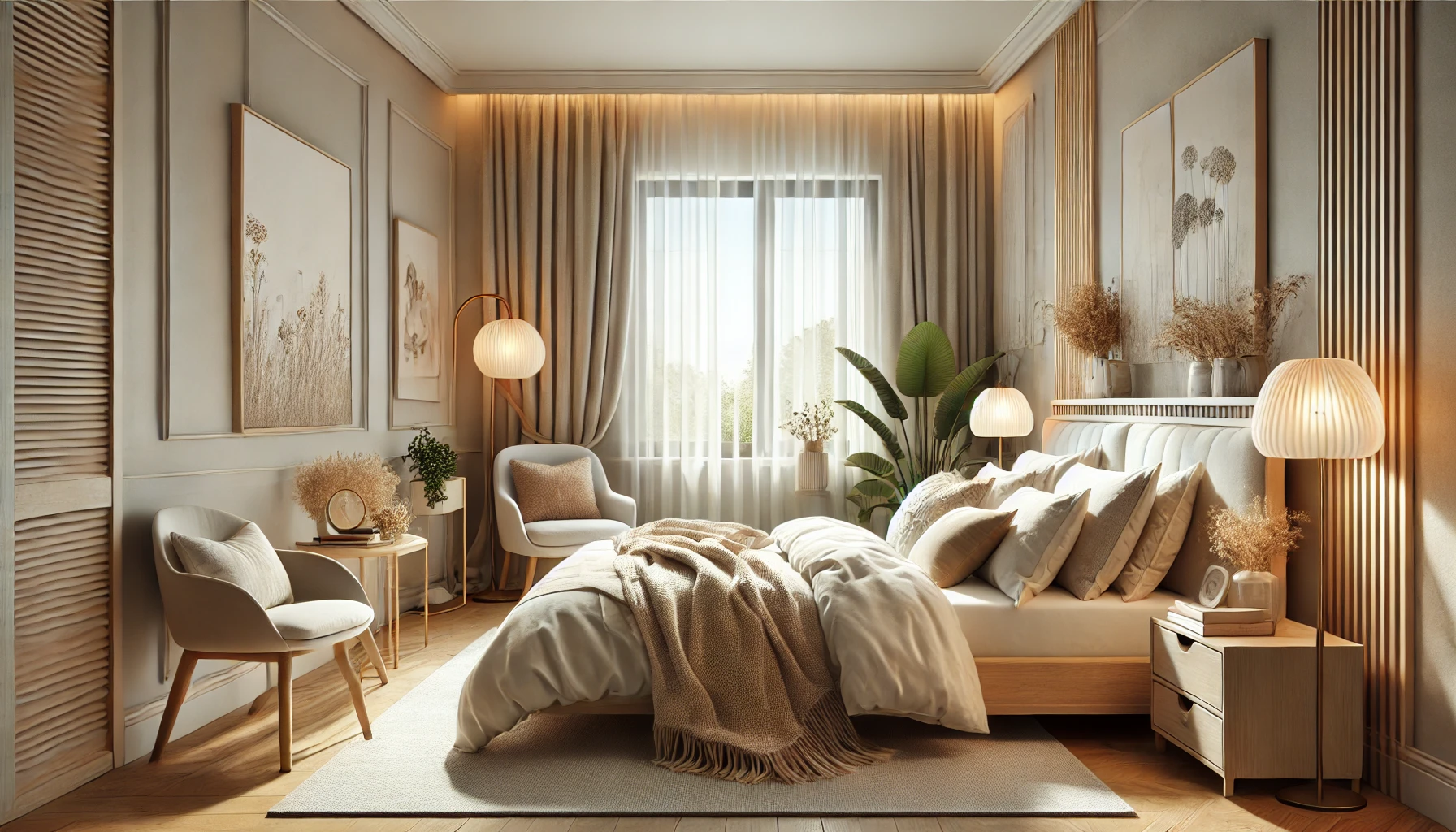A well-designed bedroom is essential for restful sleep and relaxation. The right colors, lighting, and furniture choices can transform your bedroom into a peaceful retreat.
This guide will help you create a cozy and calming bedroom for better sleep.
1. Choose a Calming Color Palette
Colors influence mood and sleep quality.
Best Bedroom Colors for Relaxation:
- Soft Neutrals: Beige, taupe, or light gray create a soothing environment.
- Cool Tones: Soft blues and greens promote relaxation.
- Warm Earthy Shades: Light browns and terracotta add warmth without overstimulation.
Avoid bright or bold colors like red or neon shades, which can be too energizing.
2. Invest in a High-Quality Mattress and Bedding
Comfort is key to restful sleep.
Essential Bedding Elements:
- Supportive Mattress: Choose memory foam, hybrid, or innerspring based on your preference.
- Soft, Breathable Sheets: Cotton or linen provide maximum comfort.
- Cozy Pillows: Pick pillows that suit your sleeping position.
- Weighted Blanket: Can reduce anxiety and promote deeper sleep.
A well-chosen mattress and bedding set improve sleep quality significantly.
3. Use Soft and Warm Lighting
Lighting affects your ability to relax before bed.
Best Bedroom Lighting:
- Warm LED Bulbs: Mimic natural evening light.
- Dimmable Lamps: Allow you to adjust brightness as needed.
- Bedside Table Lamps: Provide gentle light for nighttime reading.
- Fairy Lights or Candles: Add a cozy, intimate glow.
Avoid bright white or blue lights before bedtime, as they interfere with melatonin production.
4. Declutter and Organize for a Calm Space
A cluttered space can cause stress and anxiety.
Decluttering Tips:
- Use Under-Bed Storage: Store extra blankets, shoes, or seasonal clothing.
- Minimal Nightstand Setup: Keep only essentials like a lamp, book, or alarm clock.
- Closet Organization: Use baskets, dividers, and shelves to keep clothes tidy.
A clean and organized bedroom promotes relaxation.
5. Add Soft Textures for Comfort
Soft textures enhance coziness and warmth.
Ways to Incorporate Texture:
- Plush Area Rugs: Make the space feel warm and inviting.
- Layered Bedding: Combine different fabrics for extra comfort.
- Curtains or Drapes: Soften the room’s overall look and provide privacy.
Textures add a sense of depth and luxury to your bedroom.
6. Control Noise for a Peaceful Sleep
Noise disturbances can disrupt sleep patterns.
Soundproofing Solutions:
- Heavy Curtains or Soundproof Blinds: Block outside noise.
- White Noise Machine: Masks distracting sounds.
- Rugs and Upholstered Furniture: Absorb sound and reduce echoes.
A quiet environment enhances sleep quality.
7. Use Aromatherapy for Relaxation
Scents can help calm the mind before bed.
Best Relaxing Scents:
- Lavender: Reduces stress and promotes sleep.
- Chamomile: Helps with relaxation.
- Sandalwood: Creates a warm and soothing atmosphere.
Use essential oil diffusers, scented candles, or linen sprays for a calming effect.
8. Incorporate Nature with Plants
Indoor plants can enhance air quality and relaxation.
Best Bedroom Plants:
- Snake Plant: Filters toxins and releases oxygen at night.
- Lavender: Emits a soothing scent that promotes sleep.
- Aloe Vera: Improves air quality and requires little maintenance.
Greenery adds a refreshing and natural touch to your bedroom.
9. Limit Electronics for Better Sleep
Screens emit blue light that interferes with melatonin production.
Ways to Reduce Screen Time Before Bed:
- Use a Bedside Alarm Clock: Instead of checking your phone.
- Create a Charging Station Outside the Bedroom: Prevents late-night scrolling.
- Read a Book Instead of Watching TV: Helps the brain wind down naturally.
Reducing screen time before bed improves sleep quality.
10. Personalize Your Space Without Overcrowding
A bedroom should feel like a personal sanctuary.
Ways to Personalize Your Bedroom:
- Framed Photos or Artwork: Adds personality.
- Decorative Pillows and Throws: Enhance comfort and style.
- A Cozy Reading Nook: A small chair and side table create a relaxing space.
Keep decor minimal to maintain a clutter-free, calming environment.
Final Thoughts
Designing a bedroom for relaxation and sleep involves choosing calming colors, comfortable bedding, soft lighting, and a clutter-free layout. By incorporating natural elements, limiting distractions, and personalizing the space thoughtfully, you can create a perfect retreat for rest and rejuvenation.
Sweet dreams! 😴✨
